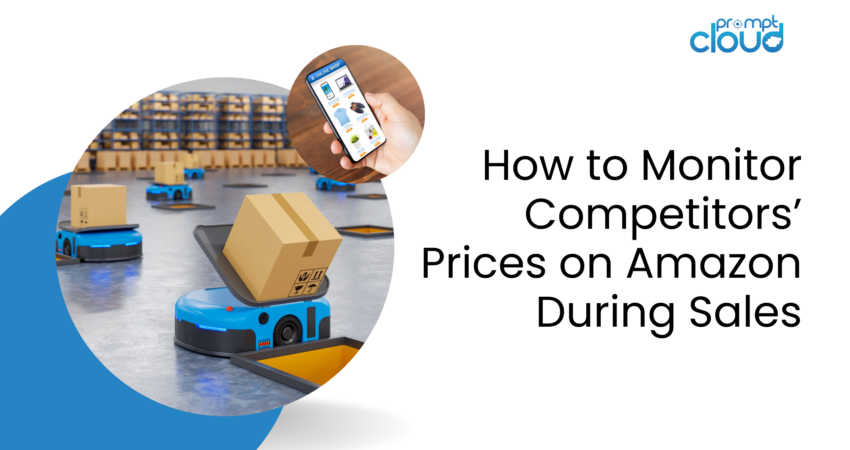
In the fast-paced world of e-commerce, staying ahead of the competition is essential, especially during sales events when prices fluctuate rapidly. Track Amazon prices to gain valuable insights that help you adjust your pricing strategies in real-time, ensuring you remain competitive and maximize sales.
Importance of Price Monitoring in Ecommerce
Sales events like Black Friday, Cyber Monday, and Prime Day are prime opportunities for e-commerce businesses to capture increased customer traffic and boost sales. However, these events also bring intense competition among sellers, making price monitoring a critical strategy for success. During these high-stakes periods, prices become a decisive factor in purchase decisions. To stay ahead, it’s essential to keep a close eye on competitors’ pricing strategies and track Amazon prices at regular intervals.
By diligently monitoring competitors’ prices, businesses can adjust their own prices in real time to remain competitive. This dynamic approach ensures that your products are always priced attractively, preventing potential customers from turning to your rivals for better deals.
Additionally, consistent price monitoring allows businesses to track Amazon prices trends and patterns. Understanding these trends can inform future pricing strategies, enabling businesses to anticipate market movements and respond proactively.
Monitoring competitor prices also offers valuable insights into their overall strategies. By analyzing how competitors price their products, especially during sales events, businesses can gain a deeper understanding of their tactics, such as which products they choose to discount and by how much. This intelligence can inform your own promotional tactics, helping you design more compelling offers that attract customers and drive sales.
Web Scraping: A Powerful Tool for Price Monitoring
Web scraping is an automated method for extracting data from websites. It enables you to track Amazon prices data, availability, and promotional offers from competitor listings. Here’s how you can leverage web scraping to track Amazon prices:
- Set Up Your Web Scraper
To get started, you’ll need a web scraping tool or software. There are many options available, ranging from simple tools to more advanced solutions like PromptCloud. Choose a service that suits your requirements.
- Identify Target Competitors and Products
Focus on identifying your key competitors and the products you want to monitor. Create a list of ASINs (Amazon Standard Identification Numbers) for these products. This will help you target your web scraping efforts effectively.
- Track Amazon Prices
Configure your web scraper to extract price data from the product pages of your competitors. This includes the list price, sale price, and any discounts or promotions applied. Ensure that your scraper is set to run at regular intervals to capture price changes in real-time.
- Collect Additional Data
Besides prices, consider collecting other relevant data such as product availability, shipping costs, and customer reviews. This comprehensive data can provide deeper insights into your competitors’ strategies and help you make informed decisions.
- Store and Analyze the Data
Once the data is collected, store it in a structured format such as a database or a spreadsheet. Use data analysis tools to identify pricing trends, patterns, and anomalies. This analysis will help you understand how your competitors adjust their prices during sales and how you can respond.
Best Practices for Amazon Web Scraping
While web scraping is a powerful tool, it’s essential to follow best practices to ensure ethical and effective use:
- Respect Amazon’s Terms of Service: Make sure your web scraping activities comply with Amazon’s terms of service to avoid any legal issues or account suspensions.
- Use API Alternatives: Whenever possible, use Amazon’s Product Advertising API, which provides structured data access without the need for scraping.
- Implement Rate Limiting: Avoid overloading Amazon’s servers by implementing rate limits and delays in your scraping requests.
- Ensure Data Privacy: Handle collected data responsibly, ensuring it complies with data privacy regulations such as GDPR or CCPA.
Alternative Methods for Amazon Price Monitoring
In addition to web scraping, there are other methods to monitor competitors’ prices on Amazon:
- Price Monitoring Tools
Several third-party tools and software solutions specialize in price monitoring. These tools offer features like real-time price tracking, alerts for price changes, and competitor analysis. Examples include Keepa, CamelCamelCamel, and PriceSpider. These tools provide user-friendly interfaces and robust features that make it easy to track and analyze competitor prices without needing advanced technical skills.
- Manual Monitoring
While less efficient, manual monitoring can be useful for spot-checking prices or verifying data collected through automated methods. Regularly check competitor listings and document price changes to stay informed. This approach can be time-consuming but provides a direct way to observe market changes and confirm the accuracy of automated tools.
- Amazon’s Own Tools
Amazon provides tools like the Amazon Seller Central dashboard, which offers insights into pricing, sales performance, and competitive positioning. Utilize these tools to supplement your price monitoring efforts. Seller Central’s pricing tools can help you understand how your prices compare to the competition and make informed adjustments.
The Future of Price Monitoring in E-commerce
As technology continues to evolve, so too will the methods and tools used for price monitoring. Artificial intelligence (AI) and machine learning (ML) are increasingly being integrated into price monitoring tools, enabling more sophisticated data analysis and predictive capabilities. These advancements will allow e-commerce businesses to anticipate market trends more accurately and adjust their pricing strategies proactively.
Conclusion
Monitoring competitors’ prices on Amazon during sales is crucial for maintaining a competitive edge and maximizing sales. By leveraging web scraping and other methods, you can gather real-time data, track Amazon prices data, and implement dynamic pricing strategies. Remember to follow best practices for web scraping and consider using a combination of tools and techniques for the most effective price monitoring. With the right approach, you can stay ahead of the competition and make the most of sales events on Amazon.




















